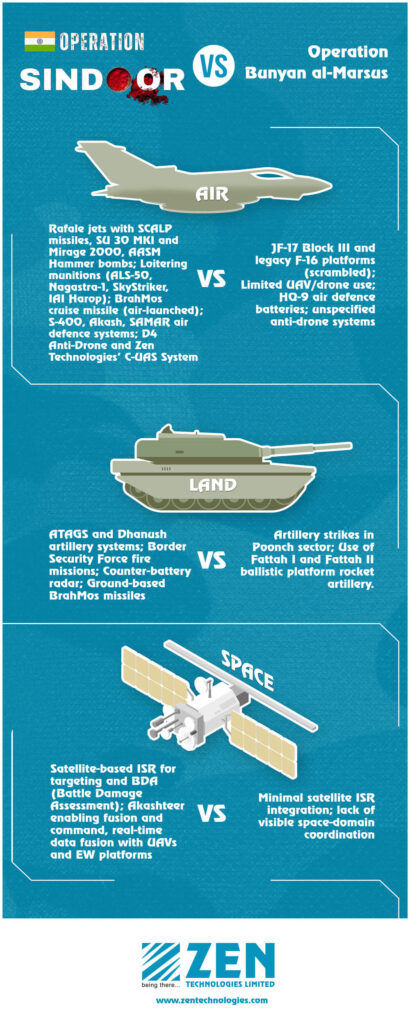
Anatomy of Retaliation: A Technical Breakdown of Operation Sindoor and Pakistan’s Response – Lessons in Rapid Multi-Domain Warfare
Every Indo-Pak crisis carries the weight of precedent. Since partition, this relationship has been less about peace and more about equilibrium—an uneasy balance maintained through a blend of diplomacy, firepower, and the quiet, continuous calibration of red lines. Yet, in every era, those red lines have been tested. From 1947 to Kargil, from Parliament to Pulwama, the challenge for India has never been whether to respond, but when, how, and with what combination of resolve and restraint.
Historically, Indian doctrine has favoured asymmetry in patience. Strategic restraint, as it evolved post-1971, was not a lack of capability but a deliberate refusal to let provocation dictate posture. That calculus began to shift with the 2016 surgical strikes, and again with the 2019 Balakot air operations. What began as calibrated counter-terror operations has now evolved into a broader doctrine of integrated retaliatory warfare—capable of combining domains, condensing timelines, and signalling strength without inviting escalation. It was within this evolved strategic mind set that Operation Sindoor was conceived and executed.
The Trigger: Pahalgam, April 2025
The catalyst was not a military manoeuvre, but an act of terror designed to provoke. On 22 April 2025, armed militants attacked innocent civilians holidaying at Baisaran Valley near Pahalgam in Jammu and Kashmir. The terrorists mercilessly sprayed bullets using the M4 carbines and AK-47s rifles, which left 26 civilians dead. It bore the hallmarks of proxy warfare—selective targeting, symbolic location, and plausible deniability. The sinister design to divide the population along religious fault lines could not be missed either. While public discourse revolved around grief and outrage, the Indian military apparatus moved with deliberate pace. Attribution was swift, confirming the attackers’ affiliation with The Resistance Front, a Lashkar-e-Taiba proxy with known cross-border logistics.
Yet, what mattered more than attribution was timing. India did not resort to a vengeance driven knee-jerk response, it prepared with cold precision to respond at a time, place and location of its own choosing.
Operation Sindoor: Doctrine in Action
Operation Sindoor was launched on the night of 6 May 2025, barely two weeks after the attack. It was not a theatrical response, nor was it a repetition of earlier patterns. It was a coordinated multi-domain campaign—executed with precision, sequenced across services, and structured to deliver maximum effect with minimal exposure. The targets were selected not only for their operational value but for what these stood for: infrastructure supporting transnational terror logistics, concealed under the civilian-military blur that has long complicated cross-border targeting.
IAF’s strike aircrafts (Rafale, SU 30 MKI and Mirage 2000) equipped with precision guided munitions like the SCALP missiles and AASM Hammer bombs, struck high-value infrastructure in Kotli and Muzaffarabad. At the same time, loitering munitions and cruise missiles like BrahMos were used to hit deeper logistical facilities across the Rawalakot-Bahawalpur corridor. These were not isolated strikes. They were nested within a layered ISR framework that included satellite reconnaissance, UAV feeds, and live electronic mapping of enemy response channels. Meanwhile, electronic warfare assets were activated to degrade communication systems across Pakistani forward command zones, further complicating any coordinated response. Air defence platforms such as the S-400, Akash, and the SAMAR air defence system were on active standby, ensuring Indian airspace remained hardened against any retaliatory incursion.
The D4 Anti-Drone System and indigenous loitering munitions like ALS-50 and Nagastra-1 and Zen Technologies’ C-UAS systems were also deployed to deny aerial surveillance and offensive drone ingress. These counter-UAS capabilities played a silent but critical role in maintaining air dominance.
At the tactical level, ground firepower was applied with restraint but precision. The Border Security Force executed fire assaults on forward launch pads and observation posts that had resumed activity following the initial air campaign. These actions were backed by counter-battery radar and real-time battle damage assessment, allowing Indian artillery—including ATAGS and Dhanush systems—to engage with surgical efficiency.
Simultaneously, India activated cyber capabilities—targeting soft infrastructure, communications, and data redundancy networks used by opposition’s military and affiliated groups. The disruption was not absolute, but it was sufficient to delay and confuse early Pakistani attempts to coordinate a counter-narrative, let alone a counterstrike. The integrated Air Defence Control and Reporting System riding on the seamless communication and connectivity of IACCS-Akashteer chain enabled the conduct of air defence battle with razor-sharp precision and lethality.
Pakistan’s Response: Kinetics Without Convergence
On 9 May, Pakistan initiated Operation Bunyan al-Marsus—a retaliatory move involving concentrated drone strikes coupled with limited artillery fire into India’s Poonch sector and a reported surface-to-surface missile launch using a Fattah I and Fattah II rocket artillery. Tragically, the action resulted in the death of one Indian soldier and several civilians. Yet, from an operational perspective, the response was conventional and split-in-parts. There was no cross-domain integration, no coordinated counter-cyber operations, and no credible interdiction of Indian forces. Pakistan also closed its airspace to Indian carriers in a symbolic move, but the military signalling remained largely reactive.
The asymmetry here was not in capability, but in cohesion. India had orchestrated a time-compressed, multi-domain response that linked airpower, ground operations, electronic disruption, and strategic communications. the opposition responded within a traditional framework—artillery for artillery, signal for signal—without managing to restore parity across the spectrum. In modern conflict, that distinction is decisive.

What Sindoor Demonstrated: Time, Tempo, and Trust in Integration
Operation Sindoor is now studied not merely for its tactical execution, but for what it signifies about India’s evolving military doctrine. The ability to integrate across domains, execute at speed, and control escalation thresholds simultaneously is a benchmark few nations meet consistently. It reflects not only capability, but institutional discipline—the kind that is built through years of training, simulation, and doctrinal clarity.
This is where industry must intersect with strategy. Technologies that support real-time decision loops, adaptive targeting, cognitive EW environments, and resilient communication nodes are no longer optional—they are foundational. Zen Technologies, as a force that stands rock-solid behind its armed forces strengthening them with its lethal C-UAS and other systems must gear up to meet the scaled-up requirement of the forces in the near future. It also must continue to innovate, adapt and assimilate key technologies in its products that will prove to be battle-winners for tomorrow. On the macro perspective, Zen’s training systems must simulate the fog of war as it exists today—not as it was in the past. Whether through AI-assisted combat decision trainers, EW simulation frameworks, or live fire-data integration, we must prepare the warfighter not for yesterday’s war, but for tomorrow’s battlespace.
A New Geometry of War
In the end, Operation Sindoor is not about retaliation. It is about coherence. It is about demonstrating that when India responds, it does so with clarity of intent, precision of execution, and control of consequence. In a region where ambiguity often fuels escalation, Sindoor stands as an example of what it means to project strength through structure—not sentiment.
Like our hon’ble PM has stated – Operation Sindoor is only ‘paused’ (not over!). That implies that this ‘Sword of Democles’ will hang perpetually over the adversary ready and waiting to slay its nefarious deigns with fatal wounds.
Jai Hind, Jai Bharat!





Leave feedback about this